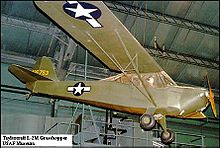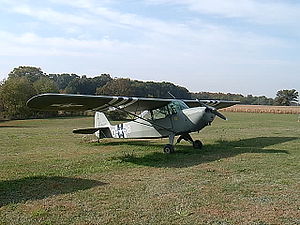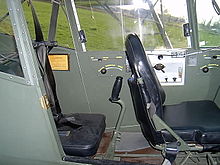- Taylorcraft L-2
-
L-2 Grasshopper Taylorcraft L-2M N52347 Role Observation and Liaison Manufacturer Taylorcraft Introduction 1941 Primary user United States Army Air Force Developed from Taylorcraft Model D  Taylorcraft L-2M at the National Museum of the United States Air Force
Taylorcraft L-2M at the National Museum of the United States Air Force
The Taylorcraft L-2 Grasshopper is an American observation and liaison aircraft built by Taylorcraft for the United States Army Air Forces in World War II.
In 1941 the United States Army Air Force ordered four Taylorcraft Model Ds with the designation YO-57. They were evaluated in the summer of 1941 during maneuvers in Louisiana and Texas where they were used for support purposes such as light transport and courier. General Innis P. Swift, commander of the 1st Cavalry Division, coined the 'grasshopper' name after witnessing a bumpy landing.[1] This led to a production order under the designation O-57 Grasshopper. In 1942 the designation was changed to L-2 Grasshopper).
In World War II, the AAF began using the L-2 in much the same manner as the observation balloon was used in France during World War I--spotting enemy troop and supply concentrations and directing artillery fire on them. It was also used for other types of liaison and transport duties and short-range reconnaissance which required airplanes that could land and take off in minimum distances from unprepared landing strips.
Postwar, a number of L-2s were civilianised and are operated by private pilot owners in the United States as the Model DCO-65. Several are still airworthy in 2011.
Contents
Variants
- YO-57
- Military version of the Taylorcraft Model D, four for evaluation with a 65hp YO-170-3, later became O-57 then L-2.
- O-57
- Production version with minor changes and a 65hp O-170-3 engine, 20 built, re-designated L-2 in 1942.
- O-57A
- O-57 with modified cabin and military radios and an observers seat that could face backwards, 336 built, re-designated L-2A
- L-2
- O-57 re-designated in 1942,a further 50 built.
- L-2A
- O-57A re-designated in 1942, a further 140 built.
- L-2B
- L-2A with modifications for artillery spotting with a 65hp Continental A65-8 engine, 490 built.
- L-2C
- 13 Taylorcraft Model DC65 impressed into Army service.
- L-2D
- One Taylorcraft Model DL65 impressed into Army service.
- L-2E
- Two Taylorcaft Model DF65 impressed into Army service.
- L-2F
- Seven impressed Taylorcraft Model BL65s with side-by-side seating and a 65hp O-145-B1 engine, one originally designated UC-95.
- L-2G
- Two impressed Taylorcraft Model BFT65s with 65hp Franklin 4AC-150 engine.
- L-2H
- Nine impressed Taylorcraft Model BC12-65s with side-by-side seating and a 65hp Continental A65-7 engine.
- L-2J
- Five impressed Taylorcraft Model BL12-65s with side-by-side seating and a 65hp O-145-B1 engine.
- L-2K
- Four impressed Taylorcraft Model BF12-65s with side-by-side seating and a 65hp Franklin 4AC-150 engine.
- L-2L
- Single impressed Taylorcraft Model BF30 with side-by-side seating and a 50hp Franklin 4AC-150 engine.
- L-2M
- L-2A with close-fitting engine cowls and wing spilers, 900 built.
- TG-6
- Model ST.100 three-seat training glider variant with enlarged fin area, wing spoilers and a simpler landing gear, 250 built.
- LNT-1
- U.S. Navy version of TG-6
- UC-95
- One impressed Taylorcraft Model BL65s with side-by-side seating and a 65hp O-145-B1 engine, re-designated L-2F.
Operators
- United States Army Air Force
Specifications (Taylorcraft L-2)
Data from Pilots Flight Operating Instructions, Army Model L-2, L-2A, L-2B, and L-2M Airplanes, T.O. No. 01-135DA-1, 1944 & The Taylorcraft Story, 1992
General characteristics
- Crew: Two, pilot and observer
- Payload: 425 lb (193 kg)
- Length: 22 ft 9 in[2] (6.9 m)
- Wingspan: 35 ft 5 in[3] (10.8 m)
- Height: 6 ft 8 in[4] (2 m)
- Wing area: 181 sq ft[5] (16.8 sq m)
- Airfoil: NACA 23012[6]
- Empty weight: 875 lb[7] (397 kg)
- Loaded weight: 1,300 lb, all models; 1,325 lb, L-2M [8] (590 kg; 601 kg, L-2M)
- Useful load: 425 lb (193 kg)
- Max takeoff weight: 1,300 lb, all models; 1,325 lb, L-2M [9] (590 kg; 601 kg, L-2M)
- Powerplant: 1 × Continental O-170-3 4-cylinder air-cooled engine, 65 hp (48 kW)
Performance
- Never exceed speed: 140 mph[10] (225 km/h)
- Maximum speed: 92 mph [11] (148 km/h)
- Cruise speed: 83 mph @2150 RPM, 74 mph @2000 RPM[12] (134 km/h @2150 RPM, 119 km/h @2000 RPM)
- Stall speed: 45 mph, power off; 43 mph, power on[13] (72 km/h, power off; 69 km/h, power on)
- Range: 228 miles @2300 RPM, 303 miles @2000 RPM (367 km @2300 RPM, 488 km @2000 RPM)
- Service ceiling: 12,000 ft[14] (3,658 m)
- Rate of climb: 395 ft/min, L-2A; 475 ft/min, L-2B; 455 ft/min, L-2M[15] (120 m/min, L-2A; 145 m/min, L-2B; 139 m/min, L-2M)
- Wing loading: 7.18 lb/sq ft ()
Armament
NoneAvionics
Learadio AMR-12 Receiver & AMT-12 Transmitter (L-2); RCA AVR-20A (L-2A); RCA AVT-15A or AVT-112 (Some L-2A, L-2M); Slipstream powered generator: Champion Model W612-6V[16]References
- ^ *Graff, Cory (2003). Shot to Hell: The Stories and Photos of Ravaged WWII Warbirds. St. Paul, MN: MBI Publishing Co.. ISBN 0760316090.
- ^ L-Birds: American Combat Liaison Aircraft of World War II 2001, p. 20.
- ^ L-Birds: American Combat Liaison Aircraft of World War II 2001, p. 20.
- ^ L-Birds: American Combat Liaison Aircraft of World War II 2001, p. 20.
- ^ L-Birds: American Combat Liaison Aircraft of World War II 2001, p. 20.
- ^ The Taylorcraft Story 1992, p. 20.
- ^ L-Birds: American Combat Liaison Aircraft of World War II 2001, p. 20.
- ^ Pilots Flight Operating Instructions, Army Model L-2, L-2A, L-2B, and L-2M Airplanes, T.O. No. 01-135DA-1 1944, p. 5.
- ^ Pilots Flight Operating Instructions, Army Model L-2, L-2A, L-2B, and L-2M Airplanes, T.O. No. 01-135DA-1 1944, p. 5.
- ^ Pilots Flight Operating Instructions, Army Model L-2, L-2A, L-2B, and L-2M Airplanes, T.O. No. 01-135DA-1 1944, p. 12.
- ^ Pilots Flight Operating Instructions, Army Model L-2, L-2A, L-2B, and L-2M Airplanes, T.O. No. 01-135DA-1 1944, p. 29.
- ^ Pilots Flight Operating Instructions, Army Model L-2, L-2A, L-2B, and L-2M Airplanes, T.O. No. 01-135DA-1 1944, p. 29.
- ^ Pilots Flight Operating Instructions, Army Model L-2, L-2A, L-2B, and L-2M Airplanes, T.O. No. 01-135DA-1 1944, p. 11.
- ^ The Taylorcraft Story 1992, p. 151.
- ^ Pilots Flight Operating Instructions, Army Model L-2, L-2A, L-2B, and L-2M Airplanes, T.O. No. 01-135DA-1 1944, pp. 26-28.
- ^ Pilots Flight Operating Instructions, Army Model L-2, L-2A, L-2B, and L-2M Airplanes, T.O. No. 01-135DA-1 1944, pp. 18-20.
- Pilots Flight Operating Instructions, Army Model L-2, L-2A, L-2B, and L-2M Airplanes, T.O. No. 01-135DA-1. Wright-Patterson AFB, Ohio: US Army Air Forces. 1944.
- Chet Peek (1992). The Taylorcraft Story. Norman, OK: Three Peaks Publishing.
- Terry M. Love (2001). L-Birds: American Combat Liaison Aircraft of World War II. New Brighton, MN: Flying Books International.
External links
- L-2 page at the National Museum of the United States Air Force
- L-2 page at Warbird Alley
- www.als-cannonfield.com - operates restored L-2s
See also
- Aircraft of comparable role, configuration and era
- Related lists
USAAF/USAF liaison aircraft USAAC/USAAF observation aircraft Observation O-1 • O-2 • XO-3 • XO-4 • O-5 • O-6 • O-7 • O-8 • O-9 • XO-10 • O-11 • O-12 • O-14 • XO-14 • XO-15 • XO-16 • O-17 • XO-18 • O-19 • YO-20 • XO-21 • O-22 • YO-23 • O-24 • O-25 • Y1O-26 • Y1O-27 • O-28 • O-29 • O-30 • O-31 • O-32 • Y1O-33 • O-34 • O-35 • XO-36 • O-37 • O-38 • O-39 • O-40 • Y1O-41 • O-42 • O-43 • XO-44 • O-45 • O-46 • O-47 • XO-48 • O-49 • YO-50 • YO-51 • O-52 • O-53 • YO-54 • YO-55 • O-56 • O-57 • O-58 • O-59 • O-60 • XO-61 • O-62 • XO-63
Observation Amphibian USAAS/USAAC/USAAF/USAF transport designations 1925–1962, 2005-2006 Main sequence
1925-1962C-1 • C-2 • C-3 • C-4 • C-5 • C-6 • C-7 • C-8 • C-9 • XC-10 • Y1C-11 • Y1C-12 • C-13 (Not assigned) • C-14 • C-15 • C-16 • Y1C-17 • C-18 • C-19 • C-20 • C-21 • Y1C-22 • Y1C-23 • Y1C-24 • Y1C-25 • C-26 • C-27 • C-28 • C-29 • YC-30 • C-31 • C-32 • C-33 • C-34 • XC-35 • C-36 • C-37 • C-38 • C-39 • C-40 • C-41/A • C-42 • UC-43 • C-44 • C-45 • C-46 • C-47 • C-48 • C-49 • C-50 • C-51 • C-52 • C-53 • C-54 • C-55 • C-56 • C-57 • C-58 • C-59 • C-60 • UC-61 • C-62 • C-63 • C-64 • C-65 • C-66 • UC-67 • C-68 • C-69 • UC-70/A/B/C/D • UC-71 • UC-72 • C-73 • C-74 • C-75 • C-76 • UC-77 • C-78 • C-79 • C-80 • UC-81 • C-82 • C-83 • C-84 • UC-85 • C-86 • C-87 • C-88 • C-89 • C-90 • C-91 • UC-92 • C-93 • UC-94 • UC-95 • UC-96 • KC-/C-97 • C-98 • XC-99 • UC-100 • UC-101 • C-102 • UC-103 • C-104 • C-105 • C-106 • C-107 • C-108 • C-109 • C-110 • C-111 • XC-112 • XC-113 • XC-114 • XC-115 • XC-116 • C-117 • C-118 • C-119 • XC-120 • C-121/F • YC-122 • C-123/A • C-124 • YC-125 • LC-126 • C-127 (I) • C-127 (II) • C-128 • YC-129 • C-130 • C-131 • C-132 • C-133 • YC-134 • KC-/C-135 • C-136 • C-137 • C-138 (Not assigned) • C-139 (Not assigned) • C-140 • C-141 • XC-142
Revived sequence
2005-2006C-143 • C-144
See also: Post-1962 listUSAAC/USAAF glider aircraft designations Assault Glider AG-1 • AG-2
Bomb Glider Cargo Glider Fuel Glider Powered Glider Training Glider USN glider aircraft designations pre-1962 Glider Bomb Pratt-ReadLBELBPTaylorcraftLBTGlider, Trainer Pratt-ReadLNELNPSchweizerTaylorcraftLNTGlider, Transport AGA AviationLRGSneadLRHLRN • LR2N
BristolLRQLists relating to aviation General Aircraft (manufacturers) · Aircraft engines (manufacturers) · Airlines (defunct) · Airports · Civil authorities · Museums · Registration prefixes · Rotorcraft (manufacturers) · TimelineMilitary Accidents/incidents Records Categories:- United States military reconnaissance aircraft 1940–1949
- World War II reconnaissance aircraft of the United States
- Taylorcraft aircraft
Wikimedia Foundation. 2010.


